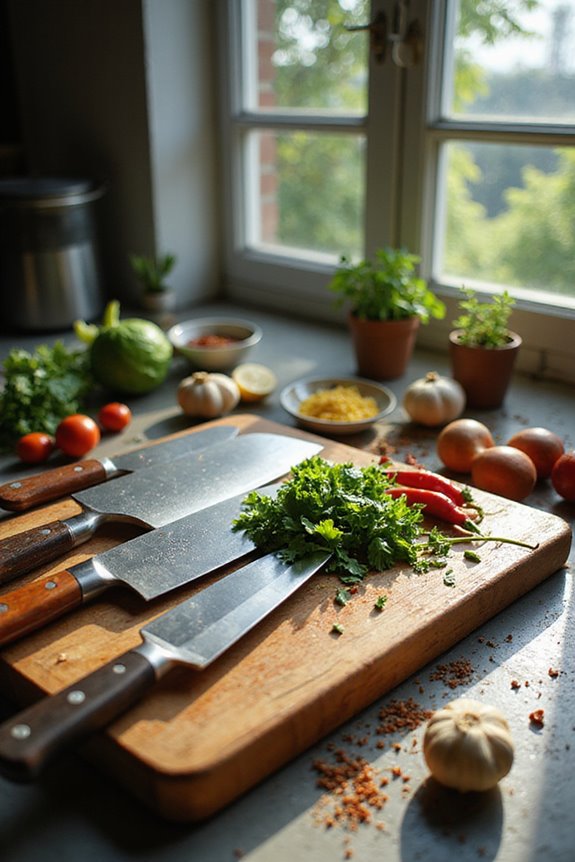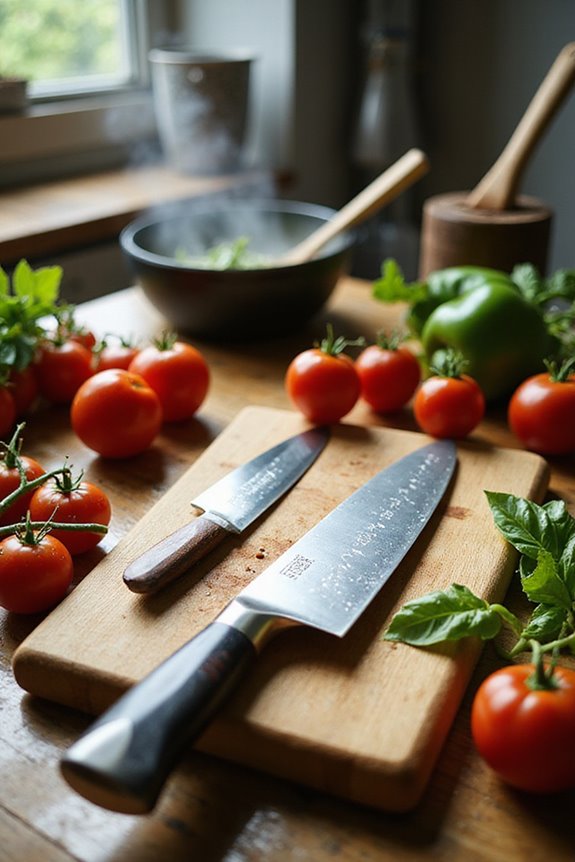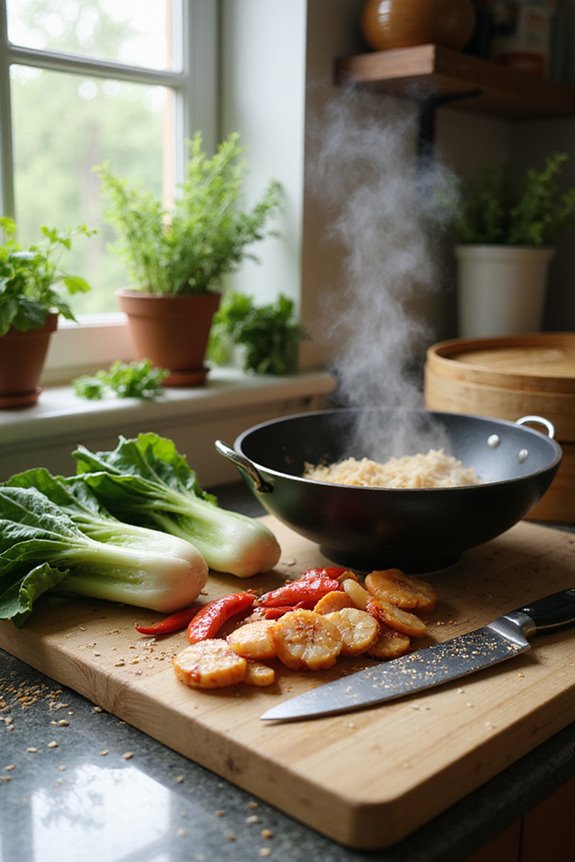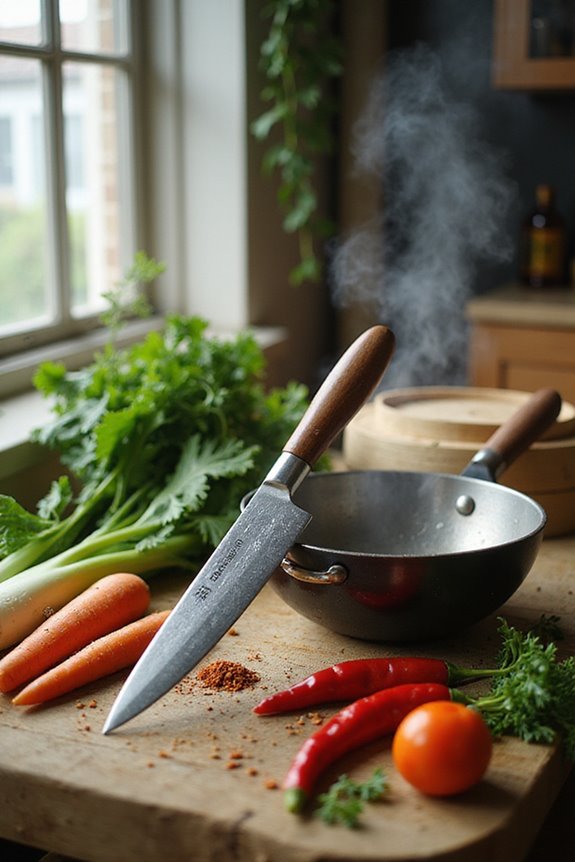As an Amazon Associate, we earn from qualifying purchases. Some links may be affiliate links at no extra cost to you. Although our opinions are based on curated research, we haven't used these products. Articles generated with AI.
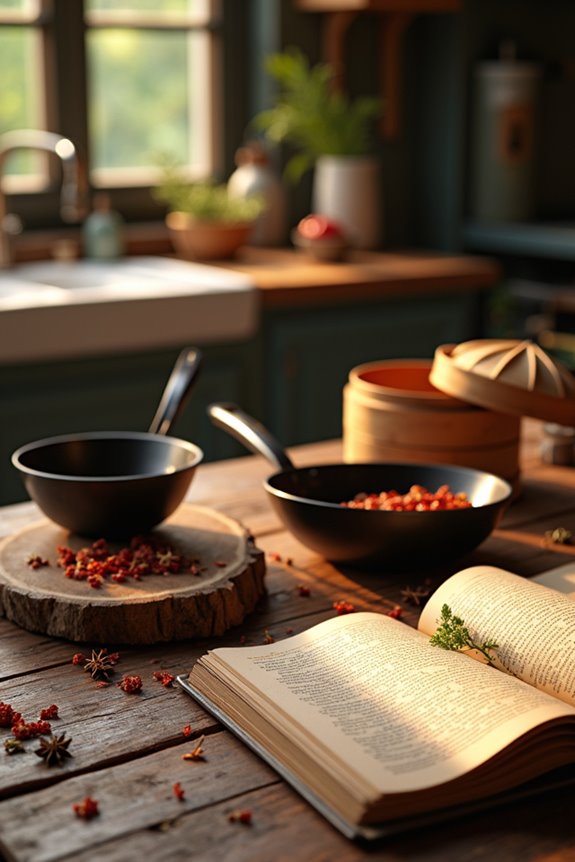
3 Best Container Garden Designs to Transform Your Outdoor Space
To transform your outdoor space with container gardening, consider three effective designs. First, use cascading plants for visual depth and vibrant blooms, ideal for balconies. Next, create a mini herb garden with various containers for easy access to fresh flavors. Finally, opt for cohesive color schemes by grouping pots that share hues. Each design enhances aesthetic appeal while accommodating plant needs like sunlight and drainage. Explore even more creative ideas for your container garden setup.
Key Takeaways
- Vertical Gardens: Utilize tall containers or trellises to maximize space and create eye-catching vertical displays with climbing plants and trailing flowers.
- Seasonal Arrangement: Select a mix of seasonal plants with staggered bloom times to maintain color and interest throughout the year in your container garden.
- Themed Containers: Design containers based on color themes or plant purposes (edible, ornamental) for a cohesive and visually appealing outdoor space that reflects your style.
- Mixed Plant Heights: Incorporate varying heights and textures in your container arrangements to add depth and visual interest, attracting attention from different angles.
- Functional Designs: Consider placing edible plants, herbs, or fragrant flowers in accessible containers, merging aesthetics with utility for a practical garden design.
The Container Garden Recipe Book
Sale
The Container Garden Recipe Book: 57 Designs for Pots, Window Boxes, Hanging Baskets, and More
- Hardcover Book
- Williams, Lana (Author)
- English (Publication Language)
If you’re a beginner looking to enhance your urban gardening skills, “The Container Garden Recipe Book” is an ideal resource for you. It guides you through selecting the right plants and containers, ensuring your gardening journey starts off smoothly. With practical designs neatly organized into six sections, you’ll benefit from step-by-step instructions paired with stunning images. Although some readers notice a missing contents page, the ingredient spotlight for plants like Scotch Moss brings valuable insight. Keep in mind, while the book focuses on aesthetic arrangements, some plants may outgrow their containers, so planning for longevity is essential in your designs.
Best For: Beginners interested in enhancing their urban gardening skills with easy-to-follow guidance and beautiful designs.
Pros:
- Offers step-by-step instructions paired with stunning visuals, making it user-friendly for novice gardeners.
- Organized into six sections, providing a variety of practical designs to inspire creativity.
- Includes ingredient spotlight pages for specific plants, offering valuable insights for selection.
Cons:
- Lacks a contents page, which may make navigation challenging for some readers.
- Focuses on aesthetic arrangements that may not prioritize long-term plant viability.
- Some plants featured may quickly outgrow their containers, leading to maintenance concerns.
Beginners Guide to Garden Planning and Design
Sale
Beginner's Guide to Garden Planning and Design: 50 Simple Gardening Ideas for Adding Style &...
- Helen Yoest (Author)
- English (Publication Language)
- 210 Pages - 06/18/2024 (Publication Date) - Creative Homeowner (Publisher)
Creating a vibrant container garden design is an excellent choice for urban dwellers and beginners looking to enhance their outdoor space without overwhelming commitment. Start by exploring Helen Yoest’s “Beginners Guide to Garden Planning and Design.” This book breaks down essential design elements like balance, scale, and rhythm, providing practical advice to shape your garden effectively. You’ll find stunning visuals that spark inspiration and communicate planting ideas. While some may wish for advanced techniques, this resource remains user-friendly, encouraging anyone to engage confidently with their garden. With Yoest’s expertise, you’ll cultivate a garden that reflects your unique style and personality.
Best For: Beginners and urban dwellers seeking to create a container garden that reflects their personal style without extensive commitment.
Pros:
- User-friendly guidance that breaks down essential design elements such as balance, scale, and rhythm.
- Inspiring visuals that provide planting ideas and enhance the overall gardening experience.
- Author’s expertise offers confidence and practical advice, making it suitable for novices and experienced gardeners alike.
Cons:
- Some readers may find the lack of advanced techniques limiting for seasoned gardeners.
- Specific design examples may not be comprehensive enough for those seeking detailed layouts.
- Reviewers note that it may not resonate with more experienced gardeners looking for advanced strategies.
The Proven Winners Garden Book
Sale
The Proven Winners Garden Book: Simple Plans, Picture-Perfect Plants, and Expert Advice for Creating...
- Clausen, Ruth Rogers (Author)
- English (Publication Language)
- 188 Pages - 02/19/2019 (Publication Date) - Timber Press (Publisher)
The Proven Winners Garden Book stands out as an essential resource for gardeners at any skill level, especially those enthusiastic to explore container gardening. It’s highly recommended for its informative yet simplified approach, appealing to both beginners and experienced gardeners alike. The book features three main sections, with the largest dedicated to container combinations, offering practical advice and beautiful plant pairings, including deer-resistant options. Stunning illustrations enhance the reading experience, providing inspiration for various garden settings. While some readers desire more about garden beds, this book serves as a valuable reference for easy access alongside your gardening tools.
Best For: Gardeners of all skill levels looking to enhance their knowledge of container gardening and plant pairing.
Pros:
- Highly informative and simplified content caters to beginners and experienced gardeners alike.
- Beautiful illustrations and pictures provide visual inspiration for various gardening scenarios.
- Practical advice and plant combinations are useful for a wide range of garden settings.
Cons:
- Some readers desired more content on designing garden beds.
- Limited variety of perennials noted by beginners, with more ideas available only on the Proven Winners website.
- Feedback indicated a desire for more diverse photography throughout the book.
Factors to Consider When Choosing Container Garden Design
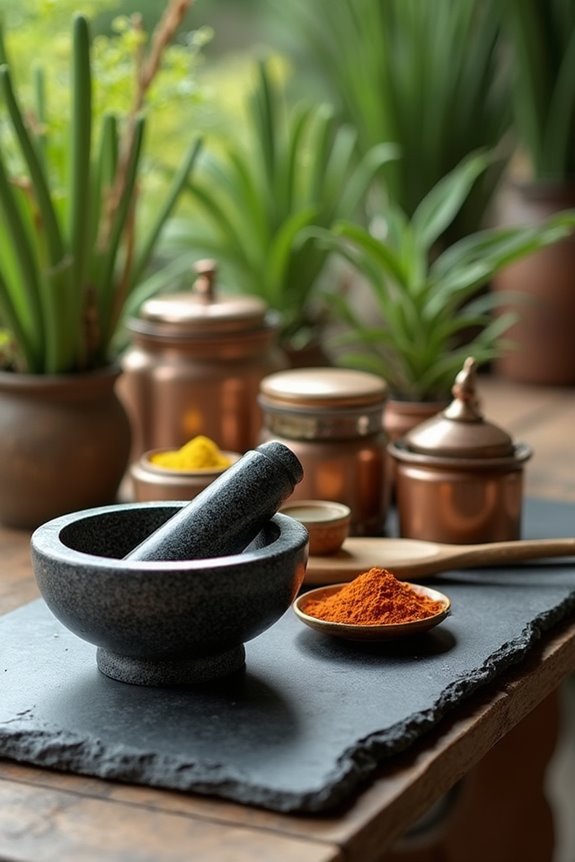
When choosing a container garden design, you need to think about several important factors. Consider your plant selection, the sizes of containers you’ll use, and how colors will work together. Don’t forget to account for sunlight exposure, drainage, and soil types, as these will greatly impact your plants’ growth and health.
Plant Selection Criteria
Selecting the right plants for your container garden is crucial for creating a thriving and visually appealing arrangement. Start by considering the plants’ growth habits to avoid overcrowding, which can hinder healthy development. Incorporate a variety of heights, textures, and colors to enhance visual interest and adhere to design principles like scale and rhythm. Assess each plant’s sunlight and shade needs to guarantee they align with your container’s location for ideal growth. It’s also essential to check the hardiness zones of potential plants; this confirms they can survive your climate’s seasonal changes. Finally, evaluate the maintenance requirements, including watering and pruning, to guarantee your gardening commitment matches the needs of your selected plants, promoting longevity in your container arrangement.
Container Size Considerations
Choosing the right size for your container is just as important as selecting the right plants. Start by considering the mature size of your plants; choosing a pot that’s too small can stifle their root systems. A good rule of thumb is to pick containers with at least a 12-inch diameter to help maintain soil moisture and promote growth. For plants like tomatoes or peppers, opt for deeper pots between 12-18 inches. Don’t forget about drainage—containers need holes at the bottom to avoid waterlogging. Finally, think about the weight; larger containers filled with soil and plants can get heavy, so place them thoughtfully in your outdoor space, ensuring they’re manageable for you to move when needed.
Color Schemes and Themes
As you plan your container garden, think about how colors can transform your space and create a cohesive look. Rely on the color wheel to find harmonious combinations, whether using complementary or analogous schemes. To draw the eye, choose a dominant color and add contrasting hues as accents, forming a focal point. Seasonal themes also play a role; vibrant colors are great for spring and summer, while warm, earthy tones suit autumn. Limit your palette to three to five colors to maintain elegance and reduce visual clutter, allowing your plants to shine. Finally, enhance your design by mixing plants with varying leaf shapes and sizes, creating textural contrast that adds further interest to your garden.
Sunlight Exposure Needs
A well-planned container garden not only considers color schemes but also aligns with the sunlight exposure in your chosen area. Most flowering plants need at least six hours of direct sunlight daily for ideal growth, so it’s essential to assess your space’s sunlight pattern. Observe how the light shifts throughout the day, as different spots may receive varying amounts of sun. Match your plant selection to their sunlight needs—sun-loving plants do best in full sun, while shade-tolerant types thrive in partial to full shade. Keep in mind that containers in full sun might require more frequent watering due to higher evaporation, whereas shaded areas may stay moister longer, impacting your watering schedule.
Drainage and Soil Types
When it comes to container gardening, neglecting proper drainage can quickly lead to problems like root rot, a common fate for plants sitting in soggy soil. To prevent this, guarantee your pots have adequate drainage holes. A lightweight, well-draining potting mix is often recommended for healthy plant growth. Consider adding a drainage layer, such as gravel or broken pottery, to enhance water flow and prevent soil compaction. Each plant has specific moisture needs, so choose soil that aligns with those requirements. Remember, regularly checking and adjusting soil pH is essential for maintaining ideal conditions for your plants. Taking these steps will set you up for a thriving container garden that flourishes beautifully in your outdoor space.
Seasonal Plant Variations
Choosing the right plants for your container garden throughout the seasons greatly impacts both aesthetics and maintenance. In spring and summer, vibrant annuals like petunias and geraniums thrive, creating lively displays. As temperatures cool, consider hardy perennials and evergreens to maintain interest during fall and winter. Understanding blooming periods helps you select combinations that offer continuous color and texture, enhancing visual appeal. For example, pansies and violas flourish in cooler weather, perfect for early spring or late fall. Mixing seasonal plants also boosts biodiversity, attracting pollinators when they’re active. Keep in mind that summer arrangements may need more watering and fertilization, while winter containers can utilize drought-tolerant varieties to ease maintenance.
Maintenance and Care Requirements
To maintain a thriving container garden, it’s essential to take into account the specific care requirements of your plants, as this enables you to create an environment where they can flourish. Consider each plant’s watering needs, sunlight preferences, and soil type; many require frequent watering, especially in hot weather. Daily checks for moisture levels are crucial. Regular deadheading and pruning can enhance growth and prolong blooming. Since nutrients deplete quickly, applying a balanced fertilizer periodically is necessary. Additionally, keep an eye out for pests and diseases, as they can spread rapidly in containers. Routine inspections and prompt treatments will help maintain your plants’ health and vigor throughout the growing season, ensuring your container garden remains vibrant and flourishing.
Aesthetic Placement Strategies
Creating a visually appealing container garden involves thoughtful placement strategies that enhance your garden’s aesthetic while ensuring your plants thrive. Start by considering color harmony; choose plants that complement or contrast effectively for added visual interest. Vary plant heights within your containers to create depth, using taller plants as focal points and shorter ones for a lush base. Employ the principle of repetition by placing similar plants in multiple containers, which helps establish a cohesive look throughout your space. Also, keep in mind the sun and shade needs of your plants, adjusting container placement for ideal growth. Finally, embrace seasonal changes by selecting plants that bloom at different times, ensuring your container garden remains vibrant year-round.
Frequently Asked Questions
Can I Use Any Container for My Garden Design?
You can use various containers for your garden design as long as they have drainage. Consider materials like plastic, wood, or metal, but make certain they’re safe for plants. Avoid anything previously used for chemicals or toxic substances. Confirm the size matches your plants’ needs—larger containers are better for root growth. You’ll want to think about the container’s weight, too, especially if you plan to move it around in your space.
How Often Should I Water My Container Plants?
You should water your container plants regularly, usually every 2-3 days, especially in warm weather. However, check the soil moisture first by sticking your finger about an inch into the soil; if it feels dry, it’s time to water. Make certain your containers have holes for drainage to prevent waterlogging. During hotter months, consider checking daily, as containers can dry out quickly. Adjust your routine based on plant needs and weather conditions.
What Type of Soil Is Best for Container Gardening?
You’ve got to use the best soil for your container garden—it’s like giving your plants a five-star hotel! Opt for a high-quality potting mix that offers good drainage, moisture retention, and nutrients. Look for one labeled “lightweight” or “container blend.” Don’t hesitate to add perlite or vermiculite for improved aeration. A mix with organic material, like compost, can also help your plants thrive while preventing root rot. Happy planting!
Can I Grow Vegetables in Decorative Containers?
Yes, you can grow vegetables in decorative containers! Just choose containers with drainage holes to prevent waterlogged roots, and use high-quality potting soil designed for container gardening. Select vegetables suited for your container size—think tomatoes, peppers, or herbs for smaller pots, and greens or squash for larger ones. Make certain they get enough sunlight, ideally six hours a day, and water consistently. This way, you’ll enjoy both beauty and home-grown produce!
How Do I Protect My Container Garden From Pests?
Imagine a fortress protecting your vibrant plants from crawling invaders. To guard your container garden from pests, start by using natural repellents like neem oil or insecticidal soap. Regularly inspect your plants for any signs of trouble, and remove infested leaves promptly. You might also consider companion planting; certain plants naturally deter pests. Finally, creating barriers, such as mesh netting, can provide an effective defense against those pesky critters looking to invade.




